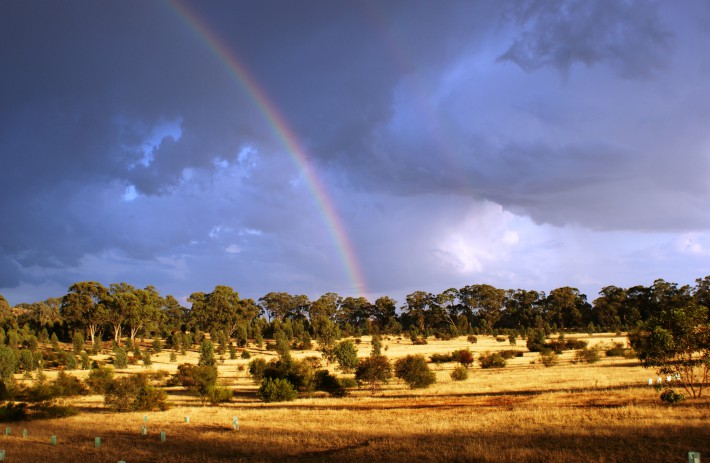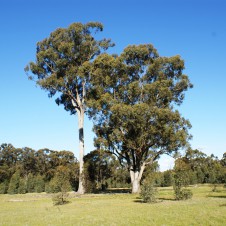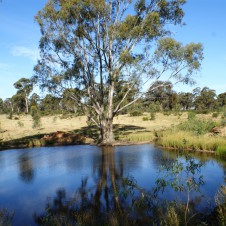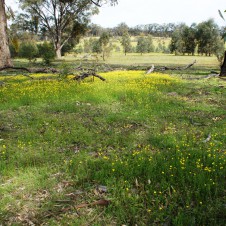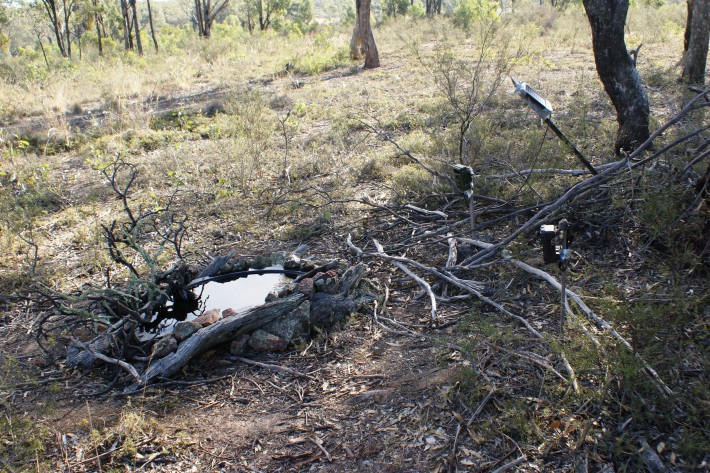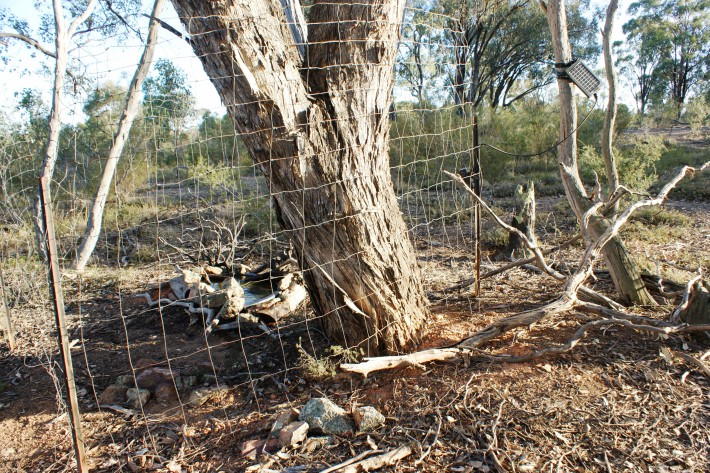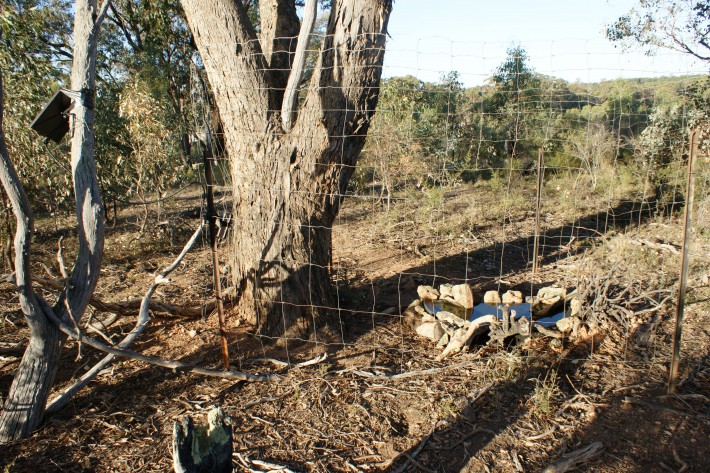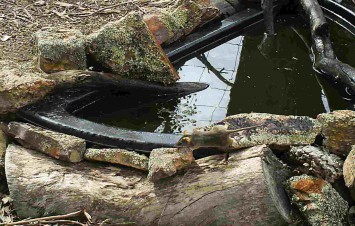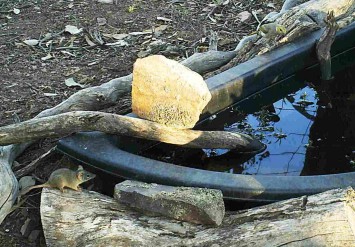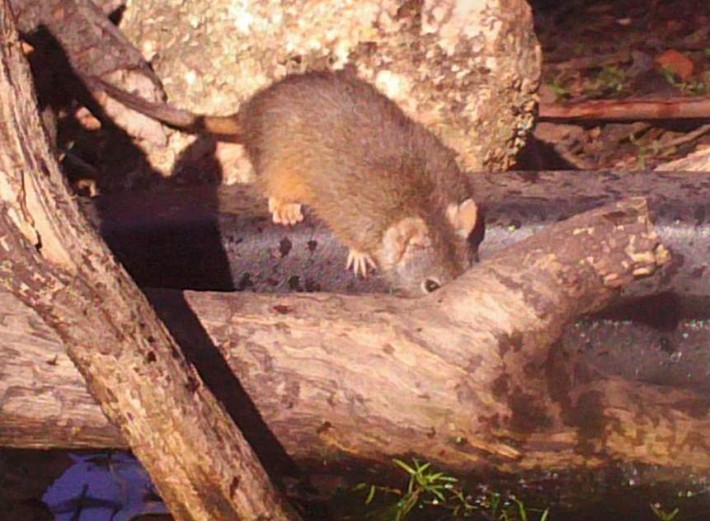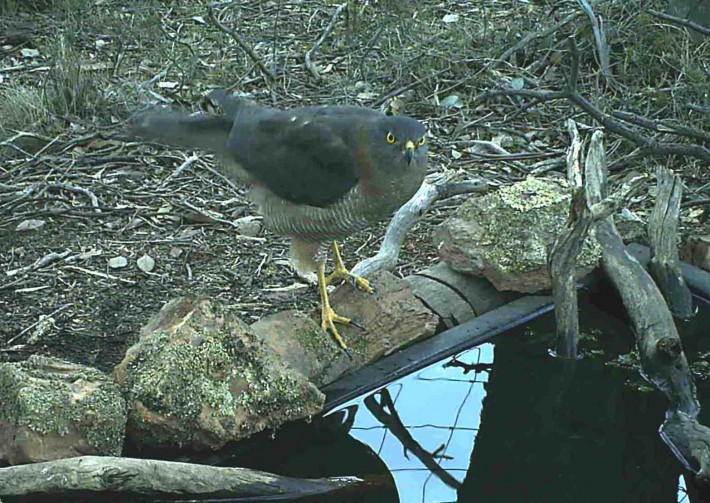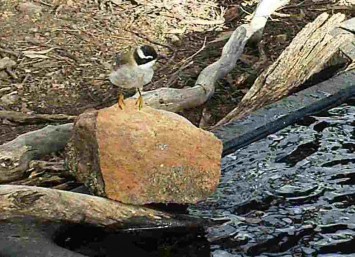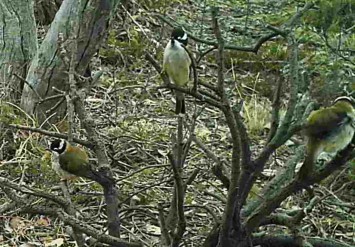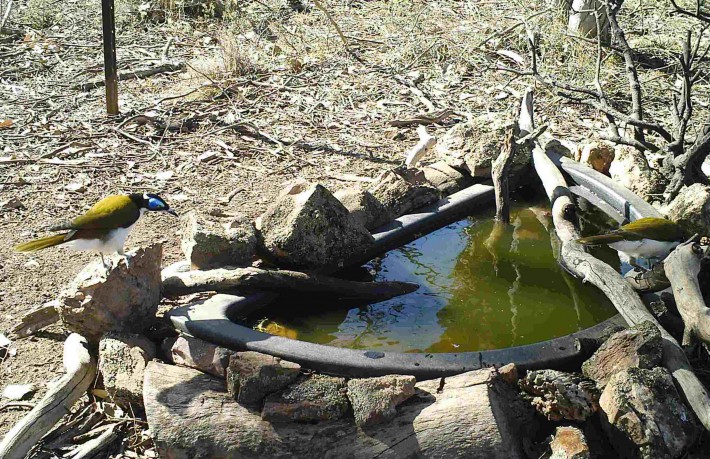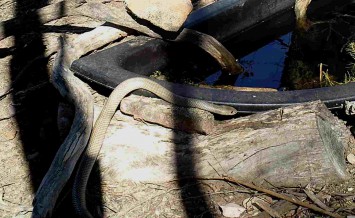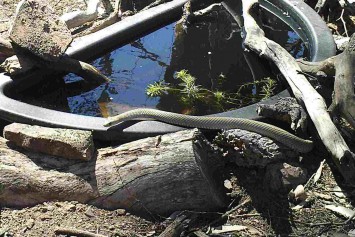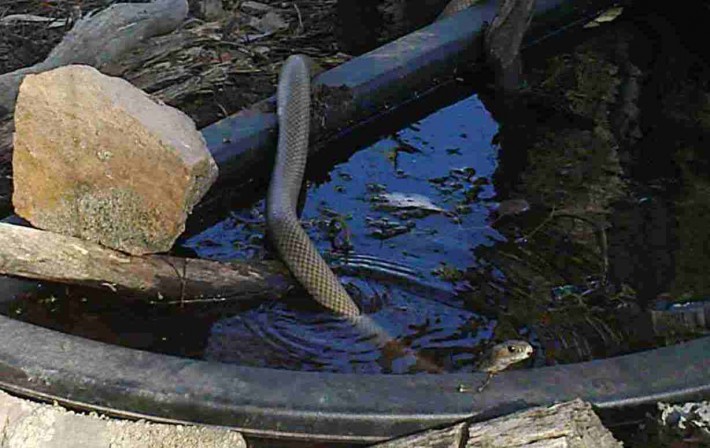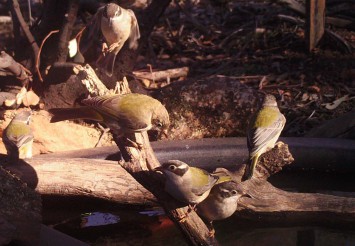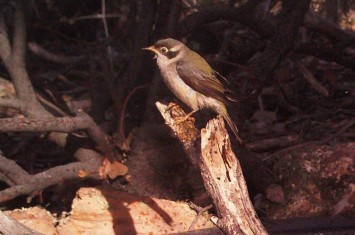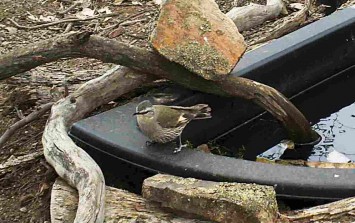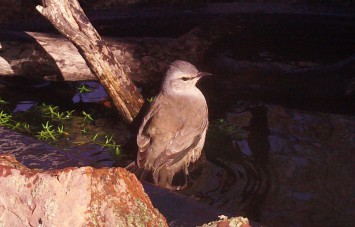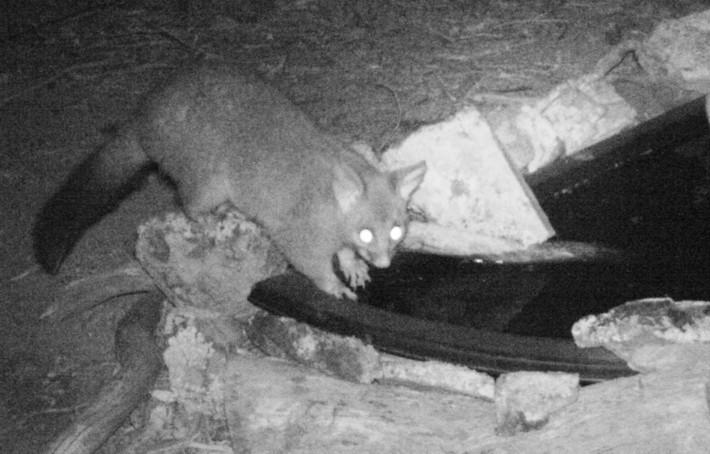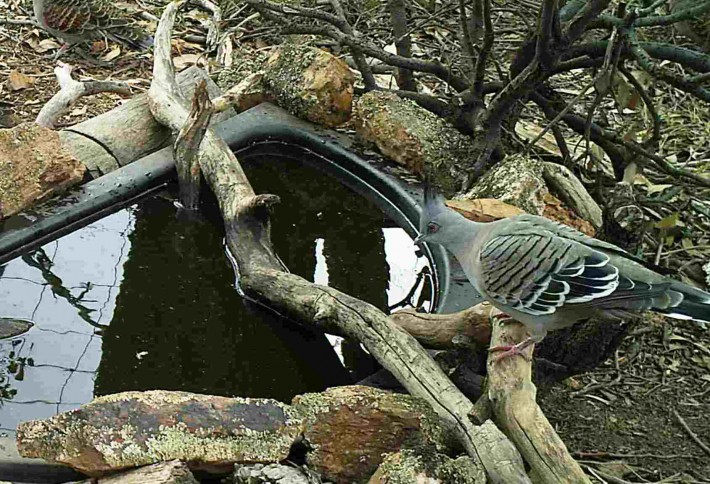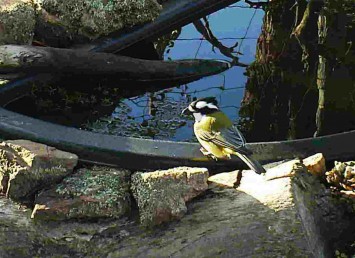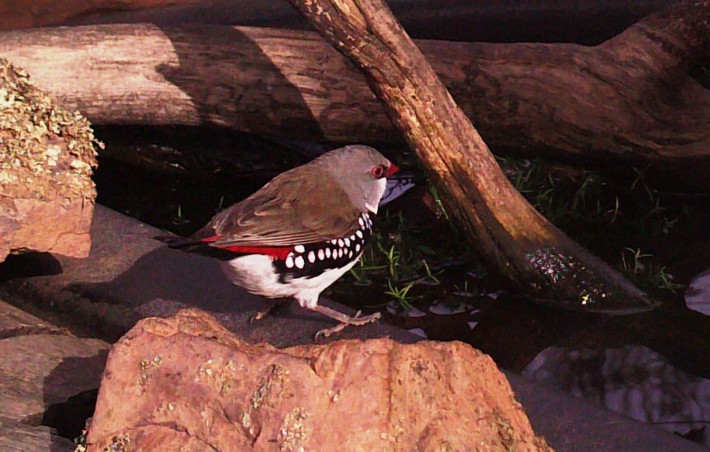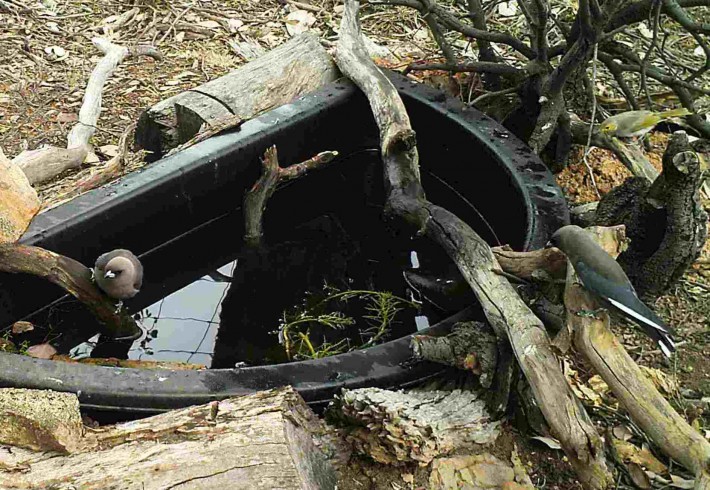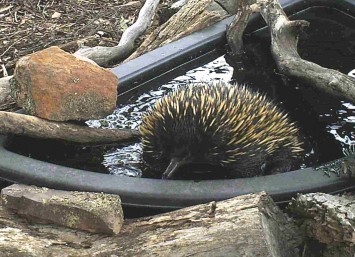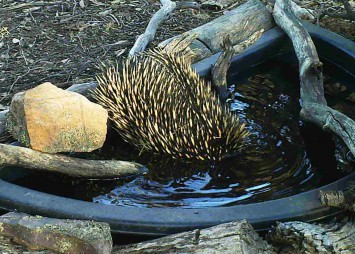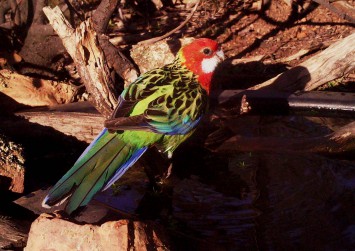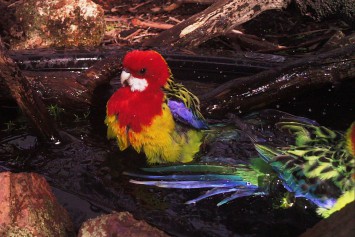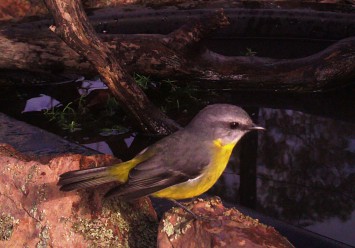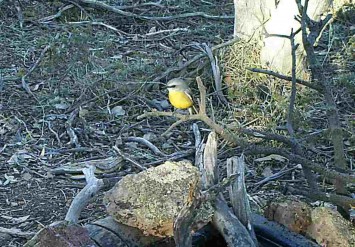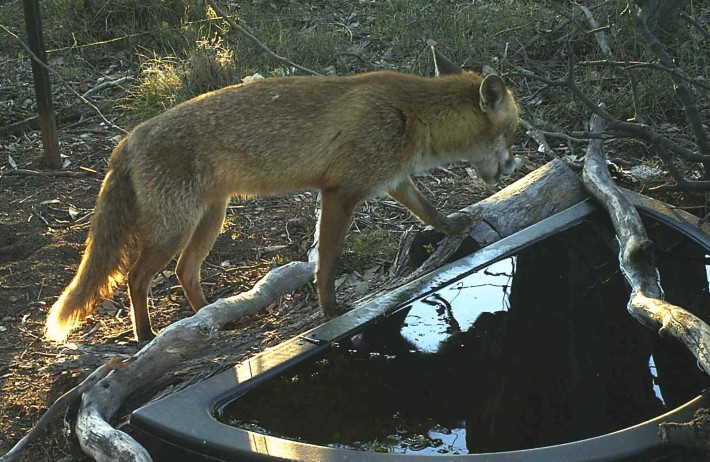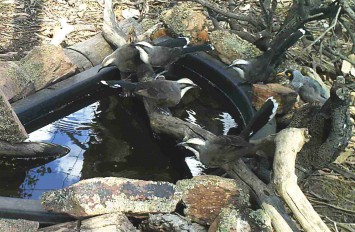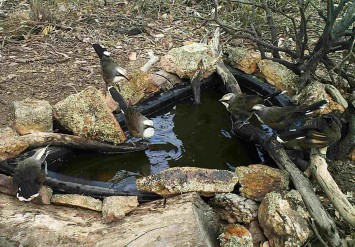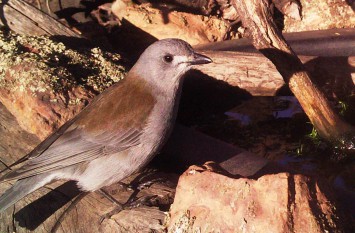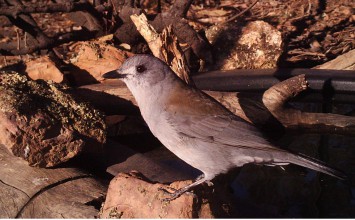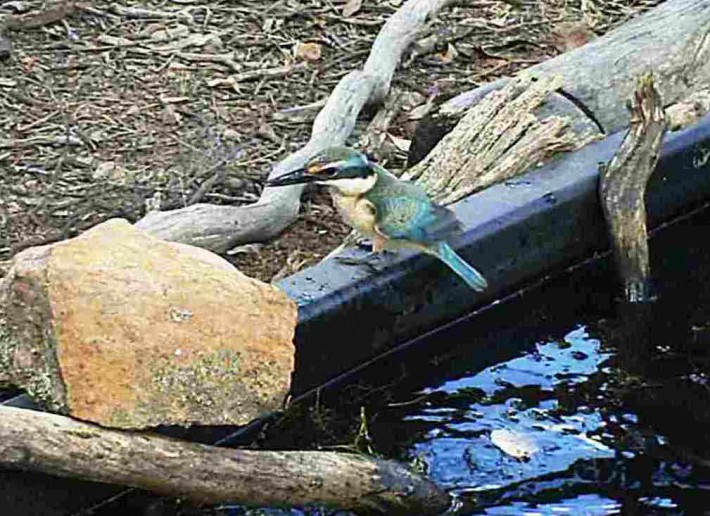We own a lovely 142 hectare (350 acre) ex-grazing property called Thorpewood . Thorpewood is located north of Violet Town, in north eastern Victoria and has a mixture of Grassy Woodland and Box-Ironbark Country. Two like-minded families joined forces and bought the property. We were attracted to its range of diverse native species- some threatened and some near threatened. We hoped to conserve and improve the property and hence, extend the range of species on the property and increase the numbers in the threatened species. At the time of purchase some very good improvement work had been started by Trust for Nature who had bought the property through their revolving fund. It was a requirement that we put a Trust for Nature covenant on the property and we were very happy to comply with this.
Even though some improvement work had been started, a great deal of important work still needed to be done. This included dealing with the rabbits, weeds and foxes, which were there in high numbers and which were increasing.
We felt frustrated because our visits to the property were taken up doing all this work, which we found very fulfilling, but which did not allow us time to survey the threatened species and to learn more about our native wildlife. Also, we are not skilled birdwatchers and felt constrained because our knowledge of calls and identifying features was often not good enough to tell species apart. So we developed a strategy to identify and monitor the wildlife on Thorpewood. This strategy runs alongside our conservation work and has proved surprisingly successful.
First we decided to try putting a birdbath in the bush with a motion sensing camera on it. We got some fascinating results, but the birdbath always dried out between our visits. So then we bought a few small plastic ponds, placed them in various differing sites around the property and put some newer/ better cameras on them. The results exceeded our expectations. The movement sensing cameras are not obvious, so we saw wildlife behaving in ways that we seldom see if we are there and affecting behaviour because of our presence.
We have decided that others, on similar journeys, might be interested in our stories and might find our experiences helpful in their own situations. So we have put this article together to start tell these stories.
We have had most of our ponds up and running for over a year now and we have also had cameras on two dams. We now have videos of 95 different species of native birds, 6 species of native reptiles and 15 species of native and introduced mammals.
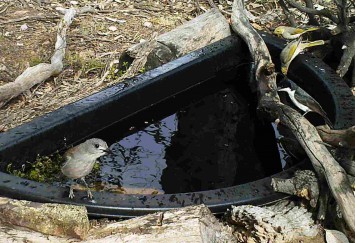
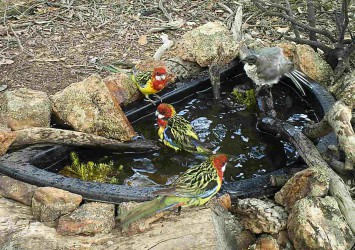
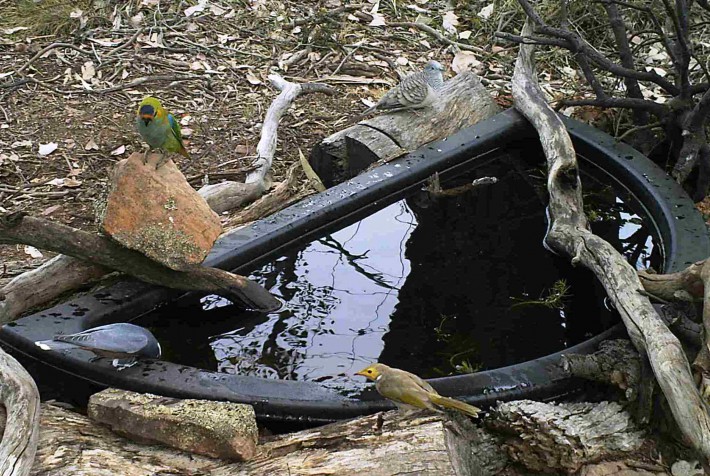
We have been fascinated by the detailed information we have obtained. Different species use different ponds and we are learning which species are resident on the property and whether they are successfully breeding. We are also able to monitor the effectiveness of our environmental work; the rabbits are no longer seen, the foxes are greatly reduced and numbers of small reptiles and ground nesting birds have increased.
It is hard to know where to start telling this story because there is so much detailed information. So, we have decided to start by telling the story of one pond (the most successful one) and we can then later add the information on the other ponds and the dams, so the data can be compared. We will also explain how the ponds are set up and maintained.
Story 1- The NW Pond
Our best pond is in the North West corner of the property, so we call it the North West Pond (NW pond) and we have videos of 55 species of birds, 10 species of mammals and 4 species of reptiles from this one pond. We have attached a copy of a spreadsheet showing the entire visitation to this one pond over a year and have included some of the photos and links to edited videos from the cameras.
(this is the order of first appearance: Black-chinned Honeyeater, Grey Shrike-thrush, Eastern Rosella x3, Rufous Whistler (female), White-plumed Honeyeater x7, Willie Wagtail, Crested Shrike-tit, Common Bronzewing, Red Wattlebird, Diamond Firetail x2, Noisy Miner x2, Grey-crowned Babbler x6, Noisy Friarbird, Magpie, Little Lorikeet x2, Red-rumped Parrot x3, White-browed Woodswallow, Peaceful Dove and Purple-crowned Lorikeet)
First we need to explain how the ponds are setup. Our advice and accompanying illustrations follow:
- Choose a spot that has a good range of wildlife and is not close to water.
- Make sure that the area is easy for you to regularly access as pond and camera will need regular maintenance.
- We prefer to put the pond in shade or semi shade on the south side of a tree so the camera can be attached to the tree or stake near tree and will face south. The tree needs to be so big that it will not move in the wind. We attach a solar panel to the north side of the tree to help power the camera.
- The pond needs to have many rocks and logs in it, so wildlife can’t be trapped in it, no matter what height the water is. Rocks and logs around the outside provide habitat for reptiles and small mammals and increase their visitation.
- The pond should include pots containing water plants. This will help to keep the water clean and fresh and mean that water creatures (such as backswimmers and waterboatmen) can be added to eat mosquito larvae. It is very important that the water stays clean, if it becomes dirty or turns green then the whole pond may need to be emptied and refilled.
- If too many visits occur from Wallabies and Kangaroos then a netting fence with big spaces will stop these species and give lots of perches for approaching birds.
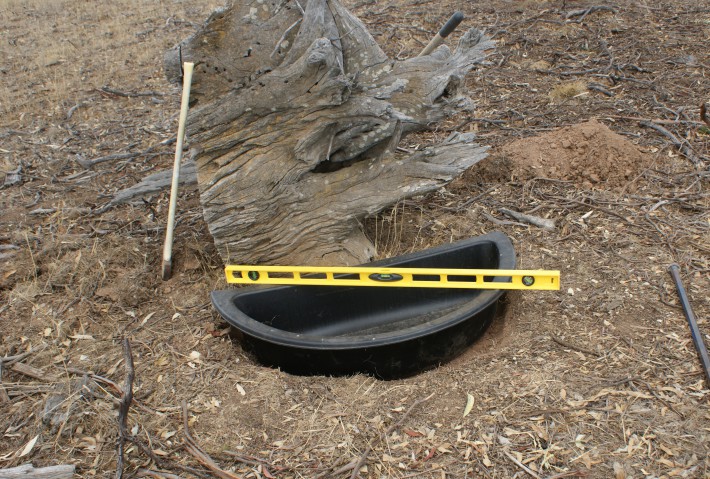
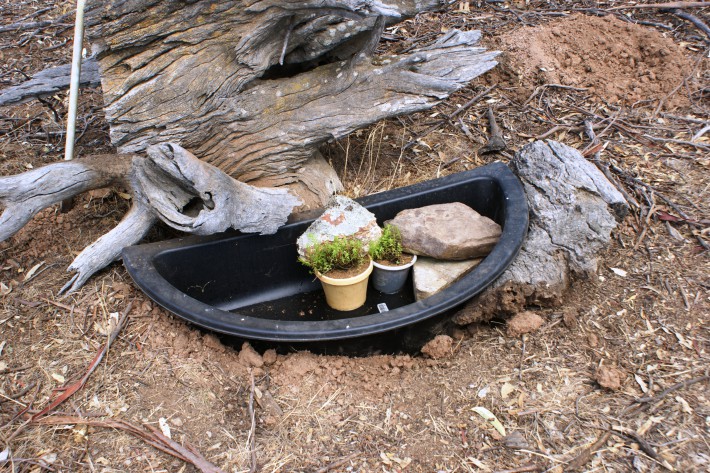
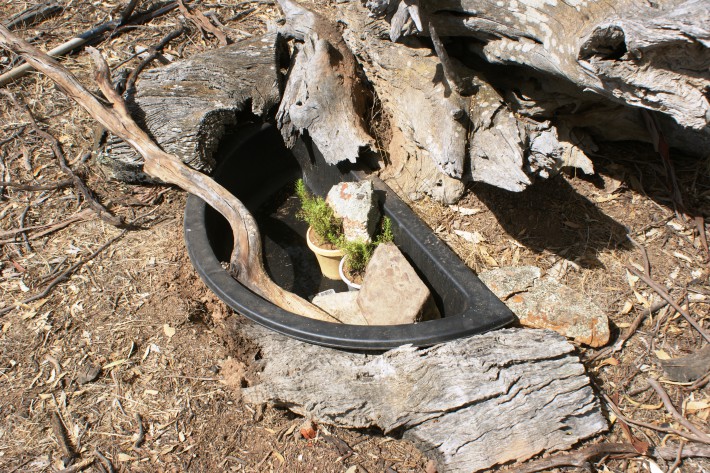
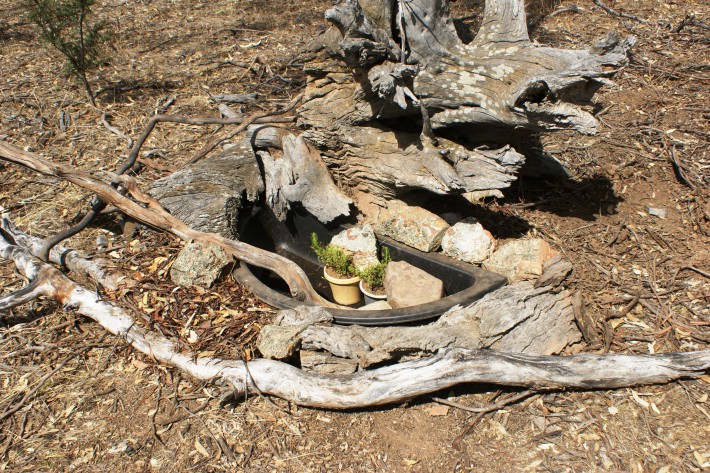
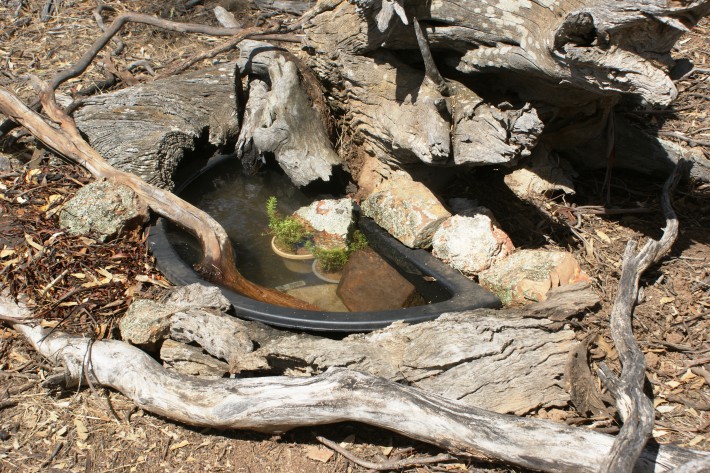
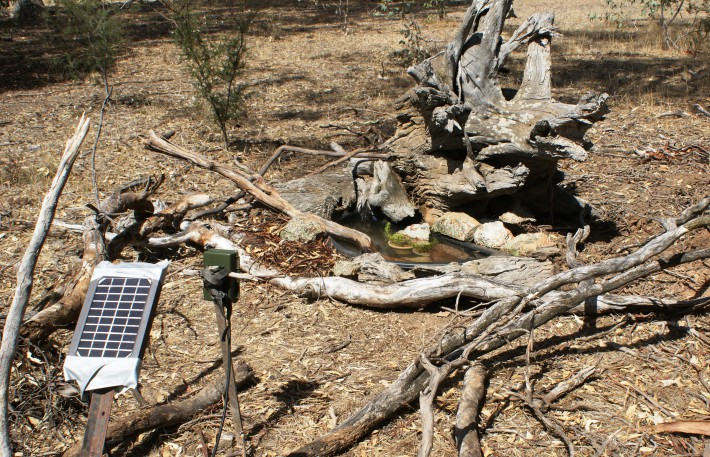
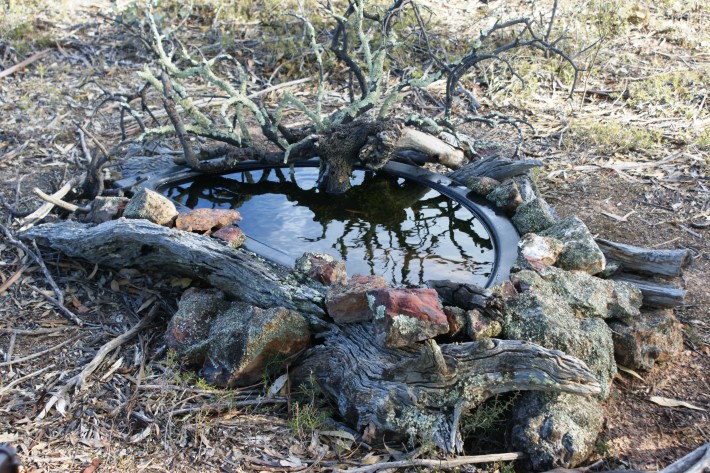
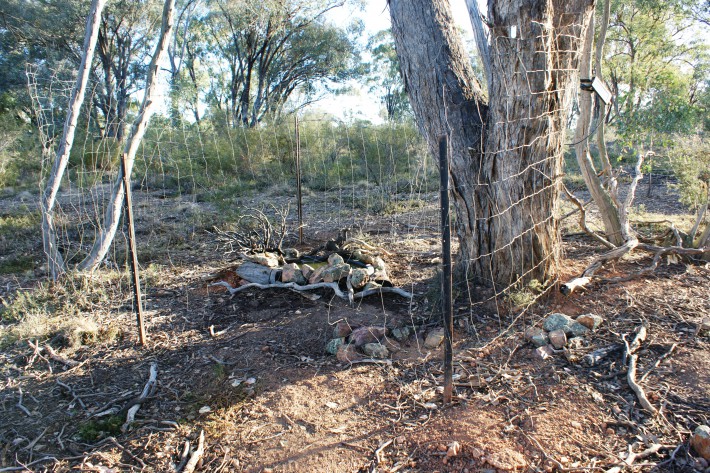
Which Wildlife Visit the NW Pond?
Yellow-footed Antechinus
This lovely little native marsupial has visited the pond a number of times each month since November 2014. Increasing the number of rocks around the pond helped to make the Antechinus a more regular visitor. This species is more active during daylight than other Antechinus so we have many daytime photos and videos. All Antechinus species are renowned for the fact that all males die after a short mating season in autumn/winter, leaving a population of pregnant females. The young of the Yellow-footed Antechinus are not weaned for 3 or 4 months, the longest time recorded for a carnivorous mammal. We hope that in the months to come, we may get video or photos of a female with young. Increasing the amount of timber on the ground will help increase the population of Antechinuses on any property. They forage with rapid jerky movements on the ground, among rocks and in trees. The Antechinus video for this description shows 4 of the many daytime videos we have and includes an Antechinus jumping on the back of a hare and one catching and killing a frog.
Brown Goshawk
The Brown Goshawk is an infrequent visitor to the NW Pond. An immature one visited in November 2014 and an adult visited in March, May and June in 2015 (the immature one is more mottled on the back and head). This fierce looking bird of prey is usually hard to see because it is shy, secretive and difficult to approach and is often only glimpsed through trees. It hunts by stealth and searches for prey from a concealed perch among foliage. It catches mostly small to medium sized birds and smaller rabbits. We would not have known that we had this magnificent bird on our property if it was not for our pond and camera. The video link shows both the adult and the immature Brown Goshawk.
Black-chinned Honeyeater
This beautiful and comic bird is listed as near threatened and was seen at the NW pond every month from December to April. For the first few visits only a single bird was seen at the pond, but over time this increased to two, and then three birds at each visit. These birds often look funny as they hang upside down like fruit bats while they search for insects and nectar (as seen on the video for this description). Black-chinned Honeyeaters have a distinctive blue eyebrow which often looks white in photos when the sun washes out the colour. Black-chinned Honeyeaters often associate with other honeyeaters and can be difficult to observe as they feed on eucalypt flowers high in the canopy. We had only seen them once before we set up the ponds.
Black-faced Cuckoo-shrike
This is an elegant grey bird with a jet-black face-mask, it has an unusual chirring song. Most birds migrate north for the winter so they are usually only seen between September and April. We had an immature one visit the NW Pond once in October (see video) and an adult visited once in November. The Black-faced Cuckoo-shrike is a tree-dweller that feeds mostly on large insects and caterpillars and it benefits from farm revegetation work. We did not see ours except at the NW Pond but they are generally noticed as they fly across open areas in a lazy, undulating fashion. They are also known for the fact that they adjust (shuffle) their wings upon landing on a perch.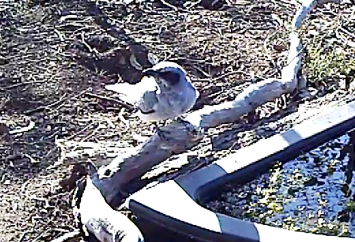
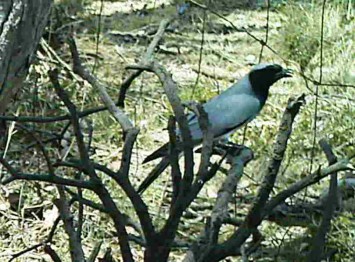
Blue-faced Honeyeater
These large Honeyeaters have striking blue faces and olive green backs. One or two birds were seen in Jan, Feb and May at the NW pond. Once again we did not see these birds on the property, except at the ponds. They are often found close to water. This honeyeater can aggressively defend food sources from other nectar eating birds and is often part of a community dominated by common resilient birds such as Noisy Miners, Magpies, Galahs, Eastern Rosellas, Grey Butcherbirds and Crested Pigeons. This appears to be the case with our birds, which came with eight Noisy Miners on one occasion and with a Grey Butcherbird on another (as seen on the video for this description). Blue-faced Honeyeaters mostly nest by adding to and relining the abandoned nest of a Babbler, Friarbird, Noisy Miner, Red Wattlebird or Magpie. They also occasionally associate with the much more rare Grey-crowned Babblers and unfortunately sometimes steal their nests.
Eastern Brown Snake
This is a fast moving species that is active during the day and is commonly seen in the hottest parts of the day. It is probably the most frequently encountered large venomous snake. The NW Pond was visited by an Eastern Brown Snake on five different days between Oct and Dec and once in Feb. It is interesting that it did not visit again, but instead a Red-bellied Black Snake visited once in March and April and twice in May.
Eastern Brown Snakes are extremely defensive when provoked and have a nervous disposition. Their venom rating has been upgraded and it is now Australia’s second most venomous snake. If provoked it may raise its fore-body off the ground to form an ‘s’ shape and open its mouth. Females lay 6 to 35 eggs in a cavity under rocks or logs in late spring and the young emerge in late summer. Brown Snakes are known to overwinter in the burrows of other animals, particularly rabbits. On our video you can see a Brown snake come into the picture from the left background. Then you can see one move around the top of the pond and lastly one going through the water.
Brown-headed Honeyeater
This endearing small honeyeater is part of the threatened ‘Temperate Woodland Bird Community’ and is a regular visitor to the NW Pond. Single birds visited from Sept to Dec and then numbers increased over the next months until we had 9, 12 and 10 birds visit at the same time, many times, in March, April and May (they are usually known to be in flocks of 5 to 15 birds). Numbers visiting the pond reduced again in June to August, but it appears that this is probably a resident species that is breeding successfully because there were many immature birds amongst the flock in the summer months. This busy small bird is often in mixed flocks with White-plumed Honeyeaters but it has a distinctive friendly, chattering contact call that can be heard on our videos if you follow the link below. Brown-headed Honeyeaters have an acrobatic flight and are always on the move. They roost communally at night by huddling together on a branch. They are difficult to observe as they mainly forage in the canopy and flit between trees.
Brown Treecreeper
This well camouflaged bird is listed as near threatened and is resident on our property. We often see them hopping across the ground or spiralling up tree trunks. They usually call constantly while foraging, and this helps to see them as they search for grubs under the bark. They were seen at the NW Pond every month from September to July. First a single bird was seen at a time and then two and lastly three together from Oct to Jan. At least one of these was a young bird that was often calling for its parents (see video). The Brown Treecreeper spends much of its time on the ground feeding on insects and ants among the bush debris. You can encourage this bird by leaving fallen branches, leaf litter and dead standing trees. They nest in tree hollows and will sometimes resort to using stumps or even fence posts.
Females disperse from the breeding groups but sometimes find it hard to reach new areas unless they are linked by corridors. The females are unable to reach groups that are more than 2 kilometres away and this can result in groups that are comprised of males only.
Brushtail Possum
This large, mostly arboreal, marsupial did not start to visit the NW pond until January but then visited very regularly at night (about 7 times a month) till June. It always comes alone and we have not been able to tell if there is more than one individual. This is a rather solitary species which resides in established territories of about five hectares so it is quite possible that it is always the same one (see video). Brushtailed Possums feed mainly on eucalypt and acacia foliage including blossom and buds. They also occasionally feed on large moths, eggs and nestlings from bird nests. Brushtailed Possums also have a well-documented love of eating mistletoe and there is good evidence that they help to keep this useful native parasite in balance. Den sites are usually large tree hollows so it can help to provide suitable nesting boxes if you have a problem with too much mistletoe on your trees.
Superb Fairy-wren
These delightful little blue and brown birds are a great favourite of many people because they look sweet as they hop around on the ground in their family groups. They first visited the NW Pond in January, and from then till July they visited regularly, with between 4 and 7 individuals at a time. These ground feeding birds require dense shrub cover for protection from predators and prefer to nest in dense prickly shrubs. If you are killing weeds such as Blackberry or Gorse, it is important to replace them with small prickly local natives such as some Wattles, Sweet Bursaria or Hakea.
Superb Fairy-wrens live in family groups with immature birds from previous broods helping to feed the next young birds. Only the female incubates and broods young. All members of the group usually contribute to the feeding of the new brood. Fairy-wrens are highly promiscuous, males almost never siring the chicks in their own nests, inseminating instead the female partners of rival male birds. Male fairy-wrens often pair up with their mothers and daughters with their fathers, but without sexual interaction.
Out of the breeding season, males change to very female like non-breeding plumage, sometimes referred to as ‘eclipse’. They retain the blue tail and black bill and do not have the red-brown colouring around the eyes (see photos below and videos for this bird).
Most males undergo full post-breeding moults, producing alternating non-breeding and breeding plumage. As males mature, the time between post-breeding and pre-breeding moults decreases so that some older males (five years or older) appear to moult directly from one breeding plumage to the next. This is uncommon, so if your blue male appears to stay blue all year round, he is special and is an older bird.
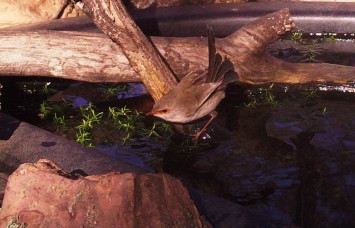
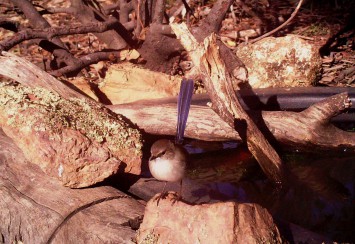
Common Bronzewing
This bird is a ground-feeding Pidgeon that often prefers to walk through the bush rather than fly. We notice them when they are disturbed and then fly low and swiftly, with wings that clatter on take-off and whistle in flight. Food includes native seeds, particularly wattle seeds, so we often see them under our wattle shrubs.
Bronzewings started to visit the NW Pond in September and by January they were mostly visiting with a maximum of 4 to 6 at a time. They visited very regularly till August and were often the first visitor in the morning and the last one in the evening.
We have found our Bronzewings to be particularly fascinating because they have a number of displays and interesting behaviour traits. The following examples can be seen from the video of this bird: first there are close-ups of a male with a yellow-buff crown and a female with a grey forehead in the background. Next the more distant shot shows the male with its crown raised, calling, with a deep “oom” call repeated every 2.5 seconds. This is followed by a male nodding to a female and slightly flapping its wings in a courtship display, which it continues even when the female is not watching. Next the male does a display where it lifts its wing and fans its tail showing the bright colours on the wings. We are unsure of the reason for this display, as no other Bronzewings appear to be present at the time. Then you can see, what appears to be, two young birds flapping and begging for food from an adult. Lastly you can see both female and male birds as they put both wings up in the air in alarm. Perhaps they think it makes them look bigger and fiercer when they have their wings up.
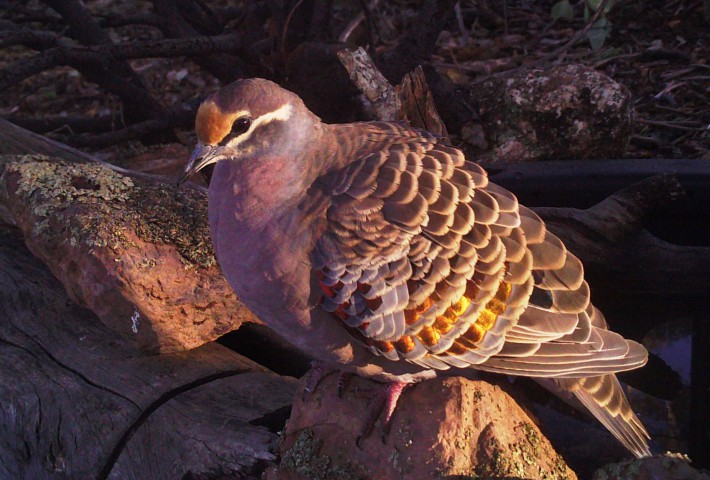
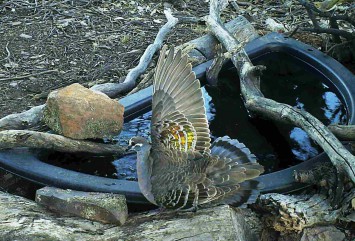
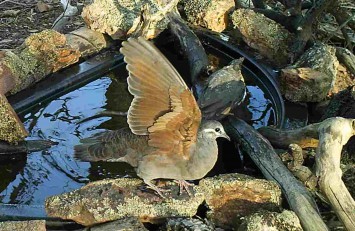
White-winged Choughs
These highly social birds live in sedentary, co-operative breeding groups of 12 to 20 birds. Choughs are noisy, active and conspicuous and we often see them as they forage on the ground tossing and raking the leaf litter in search of insects, fruits, seeds and tubers. Choughs are often seen near water and groups regularly visit the NW Pond. In Oct and Nov, groups of 6 or 7 visited and this increased to 9 or 10 at a time during December to March and then fell to just a few at a time after rain and cooler weather. Groups are composed of breeding adults and non-breeding helpers and they sometimes come close to practising slavery. To raise a chick, a pair needs at least two helpers which are usually their young from earlier broods. What marks them out as unique is that young Choughs from nearby groups are sometimes ‘kidnapped’ to serve as extra helpers. Large groups attack small groups, and during the ensuing melee fledgling birds are lured away by wing-tail displays that command a following response. Kidnap victims are fed and preened and otherwise treated well, but even so, they often wise up a week or two later and return to their former homes or go somewhere new. Those that remain sometimes fake helping, placing a morsel in a chick’s mouth then swallowing it themselves when the parents aren’t watching closely. Young choughs are fed for eight months after leaving the nest, as part of four years of adolescence.
Cooperative breeding fits with a slow progression through life. Young birds have long periods of dependency on their parents and have to be long lived to inherit vacant territory. They acquire social and other skills while they wait. Choughs can use tools, pounding old mussel shells against live ones to open them; this is a sign of their intelligence. Nests are large bowl-shaped mud structures which the family groups build together.
We have seen our Choughs doing many interesting displays by putting their wings out, their heads to one side with their mouths open and developing bright red eyes (the eye conjunctiva engorges with blood). The photos and videos show this. You can see them holding their mouths open, displaying to each other. A large group arrives loudly, all flapping their tails. Next one group comes in and is scared away by another group and lastly there is a short display in front of the pond.
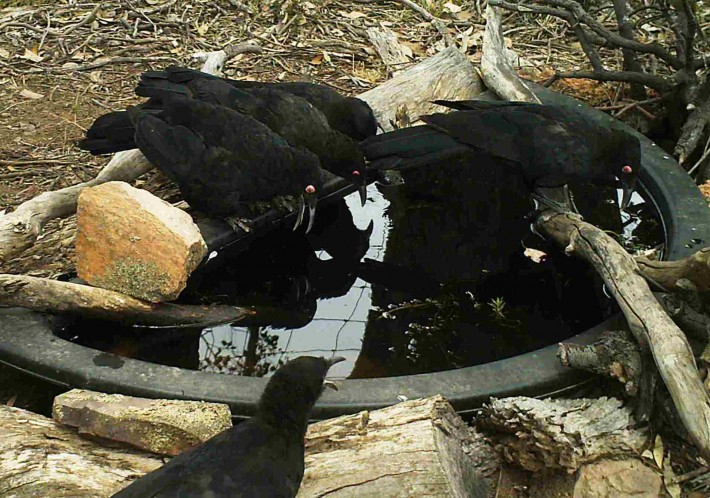
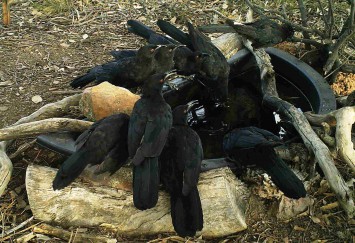
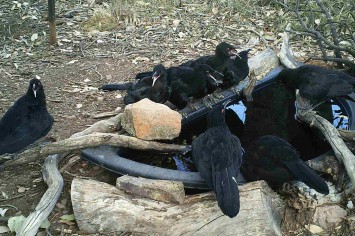
Crested Pigeon
This unusual looking bird with the punk hair-do, is an infrequent visitor to the NW Pond. A single bird visited about once a month from October to March. Crested Pigeons feed on the ground; we see them walking and pecking. If they are disturbed, they burst into flight from the ground with whistling wing beats, followed by glides. This species has benefitted from land clearing for agriculture and provision of water in farm dams. These advantageous situations have caused the Crested Pigeon’s range to expand and the population to increase. The Crested Pigeons call is a soft ‘coo’ which is given mostly when performing courting displays, but can be heard three times during the video.
Crimson Rosella
This attractive and friendly bird changes from a mostly green juvenile to a stunning crimson adult. They visit our NW Pond in autumn, winter and early spring. This species is mainly found in the southern areas of the box-ironbark country. These areas adjoin the wetter foothill forests, and Crimson Rosellas mainly nest in these areas. The ‘pair bond’ in Crimson Rosellas is very strong and mates are rarely apart; they fly and roost and feed together and both parents feed the young. It is thought that they mate for life. Juveniles stay with their parents for a few weeks (see video of close-up of juvenile and then one adult with four juveniles). After this, the juveniles form sub-adult flocks for three years and they all hang out together, like human teenagers, making lots of noise and displays and playing games. During this time the young birds meet their mates and pair bonds are formed.
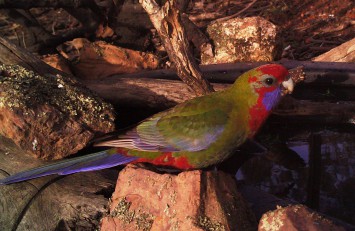
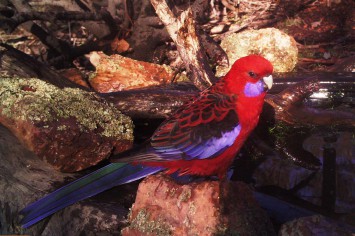
Crested Shrike-tit
With its funky crest, black and white striped face and lemon-yellow belly, the charismatic Crested Shrike-tit is a big favourite of ours. From September through to August one or two birds at a time visited the NW Pond a few times every month. Shrike-tits forage under loose flaking or long ribbons of hanging bark; they noisily tear off bark with strong beaks, probing for invertebrates, especially spiders and beetles. They feed on galls as well as insects and they are one of a range of birds essential for maintaining the health of our trees. They often hang precariously from peeling bark while investigating underneath and have also been observed using twigs as tools, inserting them into crevices to extract prey.
Shrike-tits are big-headed and thick-necked, with a chunky body and are active, agile and relatively conspicuous once spotted. In spite of this we seldom see them on the property and it is only because of our cameras on ponds that we know that they are present all year round. The beak is like a chisel with a bolt-cutter added to the end, it is a formidable weapon for levering and stripping bark aside. They can be unobtrusive and quiet, especially during the non-breeding season, but are more vocal in late winter-spring, uttering a sad slow ‘peer, peer’ whistle or a scolding chuckling noise with chattering notes (this can be heard on our video). They can also be accomplished mimics. This species will benefit from the linking of patches of vegetation of over five hectares. Shrike-tits occur mostly in patches larger than five hectares because they have a large foraging range. Females can be distinguished by their greenish (not black) throats and immature birds by their pale whitish/pale yellow throats. Our video shows a close-up of a chuckling immature bird followed by a close-up of a male. There is then a more distant video of a male and female together with the male flying towards the camera twice and the female flying lower. The female is then seen alone chattering and the video finishes with both birds again.
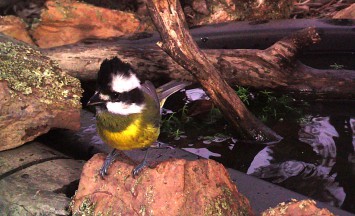
Diamond Firetail
These are beautifully marked birds that are breathtaking to watch as they move around on the ground, feeding and showing flashes of their crimson beaks and scarlet rumps. The Diamond Firetail is listed as ‘threatened’ under the Flora and Fauna Guarantee Act and as ‘near threatened’ in Victoria. They need to drink several times a day and we have been fascinated by the number of times they have visited the NW Pond. The visits were very frequent in summer (up to 19 visits in one day) but mostly by one bird at a time (out of 338 visits over 9 months 297 were of a single bird, 37 of two birds and only 4 of three birds, see below for a link to a spreadsheet of visits). Prior to the NW Pond, we only saw 2 or 3 of these birds a few times each year and did not realise they were resident on the property. So the big question was, did we have just a few birds who visited many times or many birds who visited a few times? Here’s a spreadsheet charting Diamond Firetail Visits.
Diamond Firetails have a black band across their front which continues down the flank and is dotted with white spots. We realised that the white spots formed different patterns, so individuals could be recognised. The birds are so small that it is time consuming to blow-up the images and compare the patterns but an initial study has shown that at least 10 different individuals were visiting (see photos below to see the different patterns on two birds).
We wondered if anyone else had used the spot patterns to distinguish individuals and could not find any reports of this, but we did find a very interesting scientific article (Crowhurst et al, see bibliography below) which shows that the flank spot number signals dominance in food contests in Diamond Firetail females (but not males). Females with high spot numbers feed before females with low spot numbers. Females with median spot numbers preferred to feed near females with fewer spots. Females have more white flank spots than males. Females fed before males in two-sex trials, this suggests that females are the bolder sex and may play the role of leaders.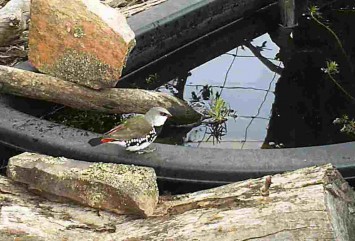
The study also found that individual spot number is consistent between years, as well as between first-year birds and adults so we are wondering if the patterns will also stay the same. We will see if we can continue to identify individual birds over the years. It is possible that spot number variation represents a case of colour polymorphism (ie different forms of adult birds caused by genetic differences). Different alternative behaviours could be associated with different grades of spottiness and the expression of different spot number could be genetically inherited. Female spot number was also positively correlated with a cell-mediated immune response. Thus, spottiness can be an honest signal of quality.
As a protein source, when moulting, Diamond Firetails like to feed on the berries of salt bushes in the autumn, so we have planted many salt bush plants to give them more feeding options.
Diamond Firetails are unobtrusive small birds and are often only detected by their call which is a distinctive drawn-out, mournful rising note, heard mostly in the morning (call can be heard at start, middle and end of video). Courtship display involves the male hopping sideways on a branch, holding a long piece of dry grass in its beak and uttering rasping notes (video shows one bird carrying grass, perhaps practicing for display?).
Dusky Woodswallow
These birds are known for their distinctive, ‘soft’, smokey brown plumage, the white edge to their grey wings, and their blue bills. Dusky Woodswallows soar and glide to catch insects in flight. They usually wheel around just above the canopy or in the sub-canopy so we did not see them except at the pond. They are regular visitors to our area in the warmer months; one to three birds visited the NW Pond at a time from September to December. From January to April one to six birds visited and this included 4 immature birds, which showed that they had bred successfully. Dusky Woodswallows live communally and groups huddle together when perched, sometimes in a tight cluster in a tree hollow. When perched, they often fan and swing their tails. Video shows two of these striking birds visiting the pond for a drink.
Short-beaked Echidna
These determined, spiny monotremes move with a slow rolling gait and if disturbed, dig down so that only their spines are showing. Echidnas are active both day and night and love to have a dip in water in the hot weather. The NW Pond was visited by an Echidna many times both during the night and day, particularly in summer. It visited once a month from July to Sept, twice a month in Dec and Jan, four or five times a month in Feb and March and only twice more from April to July. The video shows some of the times it visited and got into the water. At one point it stays under the water for a time, as if it is dead, but it is not. It scratches itself a few times and the long grooming hindclaw can be seen. Echidnas are toothless, highly specialised feeders on ants, termites and other soil invertebrates. They dig with powerful claws and then lick up food with a long sticky tongue. Hindclaws are directed backwards and the second hindclaw is the long one that is used for grooming.
Echidnas have a large home range of between 30 and 100 hectares and are usually solitary. This can change during breeding season when mature females (about five years old) are followed by amorous males. An Echidna train can form with one female being followed by many males in a line close behind. This conga line of head-to-tail Echidnas will usually only have one to four males behind the female, but as many as eleven have been seen. Echidna trains last for about six weeks and when mating occurs the males dig a trench around the female and the successful male mates with the female. They mate on their sides with their cloacas pushed together.
The single egg, and later the juvenile, is carried in the mother’s pouch until the juvenile is about seven weeks old and starts to grow spines and to outgrow the pouch. The Echidna mother then places the baby (called a puggle) into a nursery burrow. These burrows can be constructed in a wide variety of places like the bases of trees, termite mounds or under rocks or piles of leaves and sticks. This means that anyone burning off such piles in spring or early summer, risks burning a puggle. Puggles spend five months in their nursery burrow and the mother only needs to feed the puggle every five days or so. The nursery burrow has a long curved entrance, with a chamber at the back. The mother Echidna backfills the burrow when she leaves so there is no obvious hole. So the best way to burn piles that have sat for a while is to move the materials from the pile to the fire, this could also help other creatures like frogs and lizards and will prevent puggles from being burned.
Eastern Rosella
This resident, colourful parrot is a familiar sight on our property and a regular visitor to the NW Pond. We usually see pairs or small groups of Eastern Rosella, mainly feeding on seeds, fruits and insects on the ground. From July to December one to three Eastern Rosellas regularly visited the NW Pond, and then from Jan to April three to six were even more regular visitors. Rosellas nest in hollows and readily use nest boxes if protected from aggressive birds like Common Starlings and Common Mynas (luckily we do not have these pests). Eastern Rosellas are often part of a community dominated by common resilient birds such as Noisy Miners, Magpies, Grey Butcherbirds and Crested Pigeons. They often come to the NW Pond with these species and seem to hold their own.
Eastern Yellow Robin
This colourful robin is another resident species and can be seen in the more densely vegetated parts of our property. The Eastern Yellow Robin characteristically perches sideways, motionless and silent, on saplings or tree-trunks, often around clearings. From this position it pounces onto prey on the ground and returns to a perch to swallow its prey. It constantly changes foraging vantage points. The Eastern Yellow Robin has a monotonous piping call which is mainly heard at dawn and dusk. It started to come regularly to the NW Pond in November and then visited consistently and regularly, one or two at a time, every month through until August. Our video shows a fantastic close-up of one robin which puffs itself up like a powder puff.
Red Fox
Foxes are a regular threat to the wildlife on our property and this means that efforts to kill them will be ongoing. We hate killing any animals and wish we did not have to bait, but Foxes do not belong in Australia and some of our threatened species could not reproduce without this work.
Some foxes share areas and the average sized territory is 350 hectares. Others, especially young males, will roam over great distances, often covering up to 20 kilometres in one night. This means than an area which is clear of foxes can be quickly re-colonised. On-going monitoring is a crucial help in the process of knowing when to bait. We bait regularly all year so that our resident Bush Stone-curlews can safely breed, which they have done successfully for the last two years. We have also been very excited by the significant increase in young Lace Monitors that appears to have occurred since our baiting started. Here is a link to our spreadsheet in case anyone is interested in our baiting record.
When choosing baiting sites it helps to remember certain information and we found a PhD Thesis by Andrew Carter very helpful (see bibliography below). Foxes look for opportunistic sites for dens such as culverts under roads, hollows in the bases of trees or logs, old dirt mounds and rock piles; all of these make good havens for foxes. Rather than destroying known dens, it can be better instead, to bait near them, early in the breeding season every year. Roaming foxes look for prey in easily accessed areas near roadsides, creeks and tracks. So these areas are also good for baiting. To assist ground dwelling animals to avoid Foxes, create broader shelterbelts with a diversity of cover including prickly shrubs and many logs of different sizes.
When baiting it is important that the site does not look disturbed and that only fresh bait is used. Baits should not be left beyond a couple of weeks and it is crucial that all domestic dogs are excluded from the area during and sometime after the baiting program. For our property this means a permanent exclusion.
A Fox has only visited the NW Pond once in the twelve months since the pond was set. On the video the fox is seen drinking constantly this may be because it had just taken a bait. One disappeared from a baiting site near this pond at this time.
Grey Butcherbird
This medium sized carnivore feeds mainly on insects, but also takes larger prey such as reptiles and small birds. It sometimes wedges its prey into the fork of a branch for ‘butchering’, hence its name. One to four birds (including two immature birds) visited the NW Pond regularly between Jan and April. We often see these birds around the property and they are usually first detected by their loud rich call. Some of the more rollicking and harsh calls can be heard on the video. It starts with an adult that calls and an immature bird that flies away. Next there are two adults with Noisy Miners and one calls. Lastly is footage of two adults with an immature bird. They also have a beautiful distinctive piping song that we often hear in the mornings. Noisy Miners are renowned for evicting other birds (particularly smaller ones) from their territory; they break the eggs and kill the chicks of other birds. But Butcherbirds enjoy a special status. Butcherbirds join in with the attacking Miners and strike the poor victim with their far bigger beak. Butcherbirds are known not to eat Miners’ young. Butcherbirds benefit from the Miners driving off other birds that could compete for their main food, such as large insects. In some areas Butcherbirds are only found where Noisy Miners are, and they have been known to disappear when a Miner colony was disbanded. We have found that Grey Butcherbirds visit our ponds with Noisy Miners most of the time and they can be seen together on our video.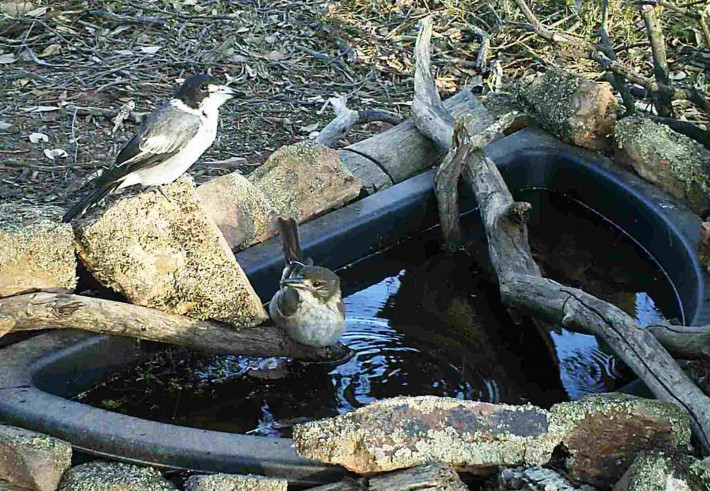
Grey-crowned Babbler
Endangered in Victoria and listed under the FFG Act, these very special, engaging birds have a bubbly personality and are a great favourite for anyone lucky enough to see them regularly. We have at least one family group resident on our property and the adjoining roadside. This group of six birds started to visit the NW Pond in December and then became very regular visitors during the hot weather from Jan to March. As can be seen on our video, they enjoy drinking, diving in and out of the water and calling to each other. Pairs often perform a distinctive antiphonal ‘ya-hoo’ duet; the female emits ‘ya’ and the male, ‘hoo’.
Grey-crowned Babblers live in family groups (mostly of 3 to 6) and they are very active, comical and playful. Australian babblers go by such names as cackler, chatterer, cur-cur, barker, dog bird, yahoo, fussy, happy jack, happy family, hopping dick, jumper, parson bird, quackie and the twelve apostles – which allude to their rowdy calls or to their gregarious ways.
Babblers live in territorial, co-operative breeding, social groups and they are rarely seen singly or in unattended pairs. Groups typically consist of a primary breeding pair and non-breeding helpers. Most young stay with the natal group until the second year when some birds disperse to fill vacancies in neighbouring groups or establish their own group. Several roost-nests are always available in a group’s territory and are kept in repair by the whole group. Babblers occupy permanent territories of mostly 2 to 25 hectares and are mostly seen foraging on the ground, in leaf litter, fallen timber and low down on trees looking for invertebrates and insects to eat.
Grey-crowned Babblers sometimes pay a price for living among Honeyeaters – they lose nests to them. In some areas, Blue-faced Honeyeaters evict Babblers so often that biologists feel that the severe effects on Babbler breeding could increase the decline which is mainly caused by habitat loss.
As groups become isolated their numbers decline to a point where they are too small to breed successfully and remaining birds eventually die.
A very recent scientific report (Peter A Vesk et al, see bibliography below) has shown that restoration work has been effective in stemming the declines in the size of Babbler groups. Habitat buffers adjacent to existing mature woodland build on, and extend, this existing resource by increasing the area for feeding but more importantly by providing more nesting and roosting sites as Babblers tend to nest in large shrubs or small trees.
Grey Shrike-thrush
This friendly thrush has a lovely rich melodious song with a wonderful range of song-notes, and moves over the ground with short bouncing hops. It has a reputation for being inquisitive and can become quite tame around habitation, nesting close to houses. We have one that spends every night in one of our outbuildings.
One to three Grey Shrike-thrush visited the NW Pond regularly during the whole year. In December a very young bird arrived and it can be seen at the end of the video being fed by a parent. The video starts with some footage of the lovely calls of a Shrike-thrush and is followed by footage of a displaying adult bowing and fanning its tail, first by itself, and then to another Shrike-thrush.
Shrike-thrush have a varied diet consisting of insects, spiders, small mammals, frogs, lizards, bird’s eggs, young birds, fruits and seeds. They are good birds to have around the house because they consume a large number of defoliating insects and their larvae (they store food in tree crevices).
Hooded Robin
With a handsome black hood extending down to its white breast the males look like they are off to a dinner party. The female has grey-brown colouring, where the male is black, and is much less distinctive. The Hooded Robin is listed as threatened under the Flora and Fauna Guarantee Act and as near threatened in Victoria. We are very lucky that this bird is a breeding resident on our property and we see it all year round. Hooded Robins have visited the NW pond every month of the year and at least one juvenile is seen with parent birds. The video shows a female first, then male and female together and then just a male, then both again. Lastly you will see both female and male with the spotted young which looks quite comic when it first appears.
These shy and quiet birds are usually seen in pairs or small groups. They perch on low exposed sites such as dead branches, tree stumps or fence posts. From these vantage points they pounce onto the ground to capture their prey (mostly insects), and then return to their perch. Like many woodland birds, Hooded Robins prefer sites with a mixture of shrubs, trees and open spaces. Studies suggest open spaces should be at least 20m wide.
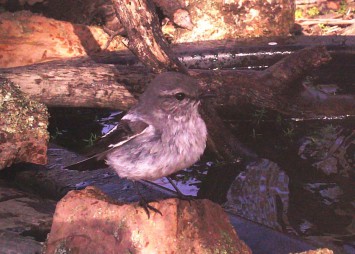
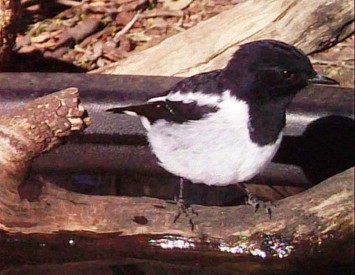
Sacred Kingfisher
This beautiful, turquoise blue, Kingfisher is a migrant from further north and is seen and heard in the warmer months of spring and summer. A single Sacred Kingfisher visited the NW Pond in Oct, Jan, Feb and March, it drinks and dives into the water (see video below). It is often solitary, it perches silently and still on a small exposed branch before diving onto prey. Their main food source is land based prey such as insects and their larvae, reptiles and crustaceans. Large prey is often beaten vigorously against a branch before being swallowed. Sacred Kingfishers lay their eggs in tree hollows, tree termite nests or in a tunnel excavated in a bank. During the breeding season their persistent, strident ‘kek-kek-kek-kek’ call can give away their presence.
Lace Monitor
These awesome and fascinating creatures are endangered in Victoria because so few young ones are now seen. This is a long lived species, so the concern is that numbers will continue to plummet because there is so little breeding (this is called an extinction debt). Lace Monitors are thought to live from 15 to 20 years on average, however many have been documented at over 20 years and some in captivity at over 40 years.
There are two colour morphs (colour variations) of Lace Monitor in the Thorpewood area; the banded ‘Bells’ form and the more typically seen highly variable ‘mottled’ form. Both colour morphs can be present in the same clutch of eggs. We have been baiting for foxes constantly for over two years and we have been amazed by the numbers of Lace Monitors we now see at our ponds and this has included many young ones. It is possible to identify different individual Lace Monitors as their markings are distinctive and appear to stay the same even though they do fade with age. We have found that the stripes on the tails are the easiest to use and we have drawn pictures of the sequence and width of dark and light stripes. Using this method, late last year, we studied all videos and photos and found that we had 9 different standard Lace Monitors and 6 ‘Bells’ (there were a couple more new ones after this work).
We had four ponds set up last summer and each one had a different small to medium ‘Bells’ which visited regularly. It is interesting that for the other 3 ponds these ‘Bells’ ones regularly went right into the water and swam. One came back so many times and stayed for so long that it was as if it was doing its regular lap swimming. None of the standard or ‘mottled’ form has so far got into the water; they just drink regularly. At the NW Pond, the ‘Bells’ variety one visited 12 times over summer (November to March) and a tiny baby one visited once (see our ‘Bells’ video). The NW Pond was also visited by three different standard monitors. We called one OBT (old bent tail), and it came for a drink seven times from October to January. Two others, called PM (pretty markings) and ‘Large’ only visited once. The video starts with ‘Large’ followed by 3 videos x 30 seconds of OBT (tail seen at end!) and finishes with 2 of PM.
Lace Monitors may grow up to 2.1m long from snout to the tip of the tail. Their tongues are long and forked like a snake’s, making monitors the only lizards that have a forked tongue. This means that they have the ability to detect airborne scent particles by flicking out their tongue. They forage for carrion, invertebrates, reptiles, small mammals and nesting birds from the ground and trees. After a large feed they are able to survive for many weeks before needing to feed again.
Lace Monitors lay six to twelve eggs; usually in a termite’s mound (they favour those at the base of a tree). The female digs a hole in the side of the mound, lays the eggs and then leaves the termites to reseal the nest. The temperature inside the mound incubates the eggs and the young have an easy meal of termites after they hatch. Sometimes the females will return months later to excavate the nest and release the young. The eggs are incubated over winter, which can take up to 10 months, and hatch in spring. The young Monitors shelter in tree hollows or fallen logs and are thought to utilise trees more than the adults, they can have a secretive life in the shelter of trees feeding on insects. It is very important to protect termite mounds as breeding sites for this species. This means leaving logs, stumps and dead trees so that termites can use them for food and to form mounds. They spend much of their time up fairly large trees, and will swiftly climb a tree when disturbed.
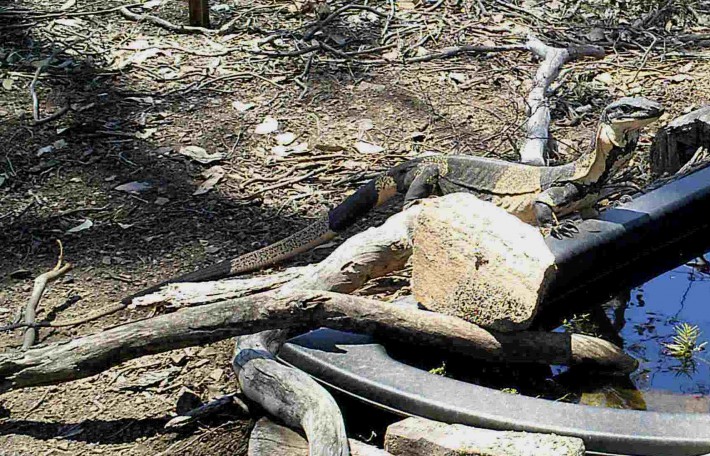
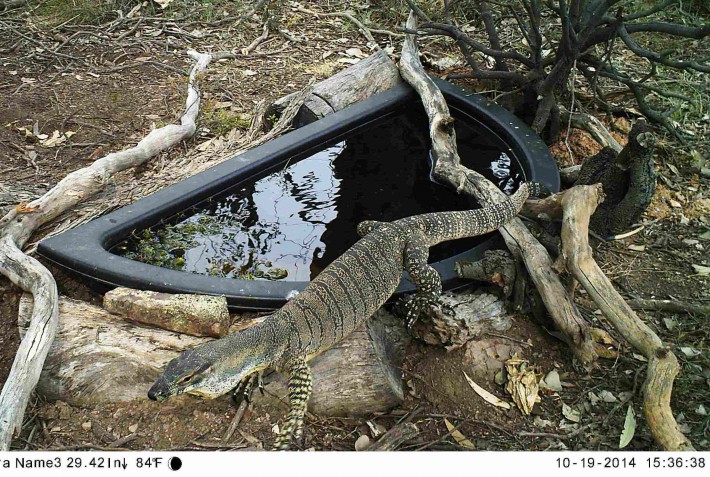
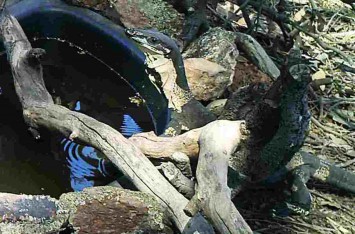
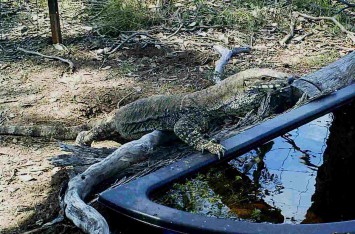
To Be Continued………..
There is more to tell of the story of the NW Pond but we need a bit more time to put information together and to edit/join and upload videos. Still to come are more threatened species like the Squirrel Glider and the Painted Honeyeater and interesting species like the Red-bellied Black Snake, Sand Goanna and Purple-crowned & Little Lorikeets.
If you are interested in getting future updates you can follow us on twitter @victoriannative
Or on our facebook page: Victorian Natives
Or subscribe to us on our Youtube Channel
Bibliography
- Handbook of Australian and New Zealand and Antarctic Birds or HANZAB, 7 volume set from Oxford University Press.
- Wildlife of the Box-Ironbark Country by Chris Tzaros from CSIRO Publishing.
- The Graham Pizzey and Frank Knight Field guide to the birds of Australia from Angus and Robertson Publishing.
- Where Song Began by Tim Low from Viking an imprint of Penguin Books.
- Daylesford Nature Diary by Tanya Loos from em Press Publishing.
- Australian Birdlife Magazines from birdlife Australia e.g. story on Crested Shrike-tits by Andrew Stafford vol. 2 no. 4 Dec 2013.
- A Field Guide to the Mammals of Australia by Peter Menkhorst and Frank Knight from Oxford University Press.
- Reptiles and Frogs by Broken Boosey and Whroo Goldfields CMNs from Goulburn Broken CMA.
- Reptiles of the NSW Murray Catchment by Damian Michael and David Lindenmayer from CSIRO Publishing.
- Improving Red Fox (Vulpes vulpes) management for Bush Stone-curlew (Burhinus Grallarius) conservation in south-eastern Australia by Andrew Carter, submitted for PhD, School of Environmental Sciences, Charles Sturt University, May 2010.
- Crowhurst Clare J, Zanollo Valeria, Griggio Matteo, Robertson Jeremy and Kleindorfer Sonia: White Flank Spots Signal Feeding Dominance in Female Diamond Firetails from Ethology journal, Final acceptance Oct 19, 2011.
- Peter A Vesk, Doug Robinson, Rodney van der Ree, Caroline M Wilson, Shirley Saywell, Michael A Mc Carthy: Demographic Effects of Habitat Restoration for the Grey-Crowned Babbler Pomatostomus temporalis, in Victoria, Australia from Plos One journal, Published July 15, 2015.

